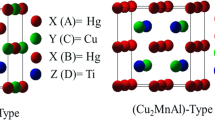Abstract
This study reports theoretical calculations of the structural, electronic, magnetic, elastic and thermodynamic properties of Cr2HfZ ternary alloys (Z = Ge, Sb, and Pb) through the Full Potential Linearized Augmented Plane Wave (FP-LAPW) method based on The Wien2k program is reported in structure type L21 (type AlCu2Mnl).The exchange-correlation potential is evaluated using the generalized gradient approximation (GGA) within the Perdew–Burke–Ernzerhof (PBE) parameterization. The calculated lattice constants for Cr2HfGe, Cr2HfSb, and Cr2HfPb are 6.1953, 6.1949, and 6.5100 Å, respectively. The electronic structures show that both compounds have Half-metallic properties by showing 100% spin polarization near the Fermi level. The mechanical stability reveals that, all our compounds are stable mechanically. The Young’s modulus, Poisson’s ratio, zener anisotropy factor and density were calculated and discussed in detail. The total magnetic moment of 4.00μB is mainly contributed by the Cr atom. Furthermore, the thermodynamic properties, such as the heat capacity \({{{\text{C}}}_{{\text{V}}}}\), the thermal expansion coefficient \({{\alpha }}\), bulk modulus \({{\beta }}\) and the Debye temperature \({{{{\theta }}}_{{\text{D}}}}\), are computed by using the quasi-harmonic Debye model within the same pressure range at a series of temperature from 0 to 1400 K. Our obtained results for these quantities make these compounds attractive candidates for materials used in spintronic devices.













Similar content being viewed by others
REFERENCES
I. Galanakis, Ph. Mavropoulos, and P. H. Dederichs, J. Phys. D: Appl. Phys. 39, 765 (2006). https://doi.org/10.1088/0022-3727/39/5/S01
T. Dietl, H. Ohno, F. Matsukura, J. Cibert, and D. Ferrand, Science (Washington, DC, U. S.) 287, 1019 (2000). https://doi.org/10.1126/science.287.5455.1019
S. A. Wolf, D. D. Awschalom, R. A. Buhrman, J. M. Daughton, S. von Molnar, M. L. Roukes, A. Y. Chtchelkanova, and D. M. Treger, Science (Washington, DC, U. S.) 294, 1488 (2001). https://doi.org/10.1126/science.1065389
G. A. Prinz, Science (Washington, DC, U. S.) 282, 1660 (1998). https://doi.org/10.1126/science.282.5394.1660
J. H. Park, E. Voscovo, H. J. Kim, C. Kwon, R. Ramesh, and T. Venkatesh, Nature (London, U.K.) 392, 794 (1998). https://doi.org/10.1007/s11664-019-07482-2
R. A. de Groot, F. M. Mueller, P. G. van Engen, and K. H. J. Buschow, Phys. Rev. Lett. 50, 2024 (1983). https://doi.org/10.1103/PhysRevLett.50.2024
G. Y. Gao, L. Hu, K. L. Yao, B. Luo, and N. Liu, J. Alloys Compd. 551, 539 (2013). https://doi.org/10.1016/j.jallcom.2012.11.077
Y. Han, Y. Wu, T. Li, R. Khenata, T. Yang, and X. Wang, Materials 11, 797 (2018). https://doi.org/10.1021/jp909021r
M. K. Hussain, G. Y. Gao, and K. L. Yao, J. Supercond. Novel Magn. 28, 3285 (2015). https://doi.org/10.1007/s11664-018-6512-2
N. Shutoh and S. Sakurada, J. Alloys Compd. 389, 204 (2005). https://doi.org/10.1016/j.jallcom.2004.05.078
C. S. Lue and Y.-K. Kuo, Phys. Rev. B 66, 085121 (2002). https://doi.org/10.1103/PhysRevB.66.085121
R. Jain, N. Lakshmi, V. Jain, V. Jain, A. R. Chandra, and K. Venugopalan, J. Magn. Magn. Mater. 448, 278 (2018). https://doi.org/10.1016/j.jmmm.2017.06.074
D. P. Rai, S. A. Shankar, A. E. Aly, P. K. Patra, and R. K. Thapa, J. Phys.: Conf. Ser. 765, 012005 (2016). https://doi.org/10.1088/1742-6596/765/1/012005
K. Özdogan, I. Galanakis, E. Sasıoglu, and B. Aktas, J. Phys.: Condens. Matter 18, 2905 (2006). https://doi.org/10.1088/0953-8984/18/10/013
X. Dai, G. Liu, G. H. Fecher, C. Felser, Y. Li, and H. Liu, J. Appl. Phys. 105, 07E901 (2009). https://doi.org/10.1063/1.3062812
I. Asfour, H. Rached, S. Benalia, and D. Rached, J. Alloys Compd. 676, 440 (2016). https://doi.org/10.1016/j.jallcom.2016.03.075
I. Asfour, H. Rached, D. Rached, M. Caid, and M. Labair, J. Alloys Compd. 742, 736 (2018). https://doi.org/10.1016/j.jallcom.2018.01.377
A. Chakrabarti, J. Bhattacharya, R. Dutt, and D. Pandey, J. Magn. Magn. Mater. 490, 165521 (2019). https://doi.org/10.1016/j.jmmm.2019.165521
A. Chakrabarti, S. W. D’Souza, and S. R. Barman, Phys. B (Amsterdam, Neth.) 407, 3547 (2012). https://doi.org/10.1016/j.physb.2012.05.021
M. Petersen, F. Wagner, L. Hufnagel, M. Scheffler, P. Blaha, and K. Schwarz, Comput. Phys. Commun. 126, 294 (2000).
P. Blaha, K. Schwarz, G. Madsen, et al., User’s Guide, WIEN2k 12.1 (Vienna Univ. of Technol., Vienna, 2012).
P. Hohenberg and W. Kohn, Phys. Rev. B 136, 864 (1964). https://doi.org/10.1103/PhysRev.136.B864
W. Kohn and L. J. Sham, Phys. Rev. A 140, 1133 (1965). https://doi.org/10.1103/PhysRev.140.A1133
J. P. Perdew, K. Burke, and Y. Wang, Phys. Rev. B 54, 16533 (1996). https://doi.org/10.1103/PhysRevB.54.16533
J. P. Perdew, K. Burke, and M. Ernzerhof, Phys. Rev. Lett. 77, 3865 (1996). https://doi.org/10.1103/PhysRevLett.77.3865
F. D. Murnaghen, Proc. Natl. Acad. Sci. U. S. A. 30, 244 (1944). https://doi.org/10.1073/pnas.30.9.244
I. Asfour, J. Supercond. Nov. Magn. 33, 2837 (2020). https://doi.org/10.1007/s10948-020-05519-w
M. J. Mehl, Phys. Rev. B 47, 249 (1993). https://doi.org/10.1103/PhysRevB.47.2493
R. Hill, Proc. Phys. Soc., Sect. A 65, 349 (1952). https://doi.org/10.1088/0370-1298/65/5/307
F. Chu, Y. He, D. J. Thome, and T. E. Mitchell, Scr. Metall. Mater. 33, 1295 (1995).
S. F. Pugh, Philos. Mag. J. Sci. 45, 823 (1954). https://doi.org/10.1080/14786440808520496
J. C. Slater, J. Phys. Chem. 41, 3199 (1964). https://doi.org/10.1063/1.1725697
R. J. Soulen, J. M. Byers, M. S. Osofsky, B. Nadgorny, T. Ambrose, S. F. Cheng, P. R. Broussard, C. T. Tanaka, J. Nowak, J. S. Moodera, A. Barry, and J. M. D. Coey, Science (Washington, DC, U. S.) 282, 85 (1998). https://doi.org/10.1126/science.282.5386.85
H. C. Kandpal, G. H. Fecher, and C. Felser, J. Phys. D 40, 1507 (2007). https://doi.org/10.1088/0022-3727/40/6/S01
M. Florez, J. M. Recio, E. Francisco, M. A. Blanco, and A. Martin Pendas, Phys. Rev. B 66, 144112 (2002). https://doi.org/10.1103/PhysRevB.66.144112
M. A. Blanco, E. Francisco, and V. Luana, Comput. Phys. Commun. 158, 57 (2004). https://doi.org/10.1016/j.comphy.2003.12.001
A. Kokalj, Comput. Mater. Sci. 28, 155 (2003). https://doi.org/10.1016/S0927-0256(03)00104-6
F. Dahmane, C. Zouaneb, A. Abdiche, H. Meradji, R. Khenata, R. Ahmed, A. Bouhemadou, S. Bin Omran, Sikander Azam, and S. H. Naqib, Comput. Condens. Matter 26, e00518 (2021). https://doi.org/10.1016/j.cocom.2020.e00518
B. E. Iyorzor and M. I. Babalola, J. Nig. Soc. Phys. Sci. 3, 138 (2022). https://doi.org/10.46481/jnsps.2021.297
Funding
This work was supported by ongoing institutional funding. No additional grants to carry out or direct this particular research were obtained.
Author information
Authors and Affiliations
Corresponding author
Ethics declarations
The author declares that he has no conflicts of interest.
Rights and permissions
About this article
Cite this article
Asfour, I. Computational Insights into the Structural, Electronic, Mechanical, Magnetic, and Thermodynamic Properties of New Half-Metallic Ferromagnetic Full-Heusler Alloys Cr2HfZ (Z = Ge, Sb, and Pb) Using FP-LAPW Method. Russ. J. Phys. Chem. 97, 2731–2748 (2023). https://doi.org/10.1134/S0036024423120026
Received:
Revised:
Accepted:
Published:
Issue Date:
DOI: https://doi.org/10.1134/S0036024423120026




